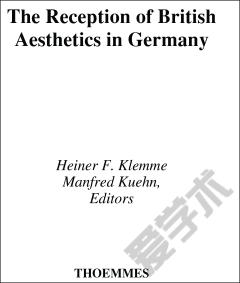The German Aesthetic Tradition
Hammermeister, Kai. The German Aesthetic Tradition. Cambridge: Cambridge University Press, 2002. 259pp. $22.00 paperback. Among the many reasons to write an academic book, the desire to provide a service is probably the least frequent. However, Kai Hammermeister obviously felt very strongly about rendering the history of German aesthetic theory from Baumgarten and Kant to Heidegger and Adorno accessible to a wider audience-whatever the cost. And there is inevitably a price to be paid for writing this kind of book, which moves briskly and without fear of strong opinions through some of the most complicated philosophical works of the past two centuries. Under the characteristically bold and blunt title The German Aesthetic Tradition, Hammermeister delivers in just over two hundred pages "the straight dope" on the leading contenders for forbidding philosophical difficulty: Fichte, Schelling, and, of course, Hegel, that famed fortress of impenetrable German prose. Unflinchingly, however, Hammermeister renders them all entirely comprehensible. Even undergraduates should have no difficulty following his expositions. Nor should one dismiss this pedagogical quality as reductive popularization. Hammermeister's book is quite an accomplishment. His highly economical presentation never fails to touch on virtually all the important issues in any given author. To be sure, one can quibble-Karl Philip Moritz seems to gets short-changed; Holderlin deserves his own chapter-but all in all, Hammermeister has succeeded in producing a perfectly coherent narrative of the development of aesthetic theory from the 18th-century to the present. Indeed, what makes this book so eminently readable are not only the succinct summaries of individual authors but their integration into an overarching three-part movement. Baumgarten, Kant, Schiller, and Schellingare subsumed under "The Age of Paradigms," followed by "Challenging the Paradigms" in the writings of Schopenhauer, Kierkegaard, and Nietzsche. The book concludes with a section entitled "Renewing the Paradigms," as Hammermeister argues that the positions of Cassirer, Lukacs, Heidegger, Gadamer, and Adorno basically reinvent the (aesthetic) wheel. Thus he claims, for example, that Adorno's and Heidegger's anti-idealist rhetoric conceals their strong allegiance-not, as one might expect, to Hegel, but rather to Schelling; like him they are said to accord art the exalted and exclusive privilege of providing access to a truth unavailable to theoretical or philosophical discourses. Beyond the incredibly useful service of introducing the uninitiated to the arcana of German aesthetics-there really is nothing comparable out there-it is this claim that post-Nietzschean theories of art not only recycle the older aesthetic tradition but follow essentially the very same trajectory that had led from Kant to Hegel in the first place, that makes this volume original, provocative, and enormously problematic. â¦
{{comment.content}}








 京公网安备 11010802027623号
京公网安备 11010802027623号